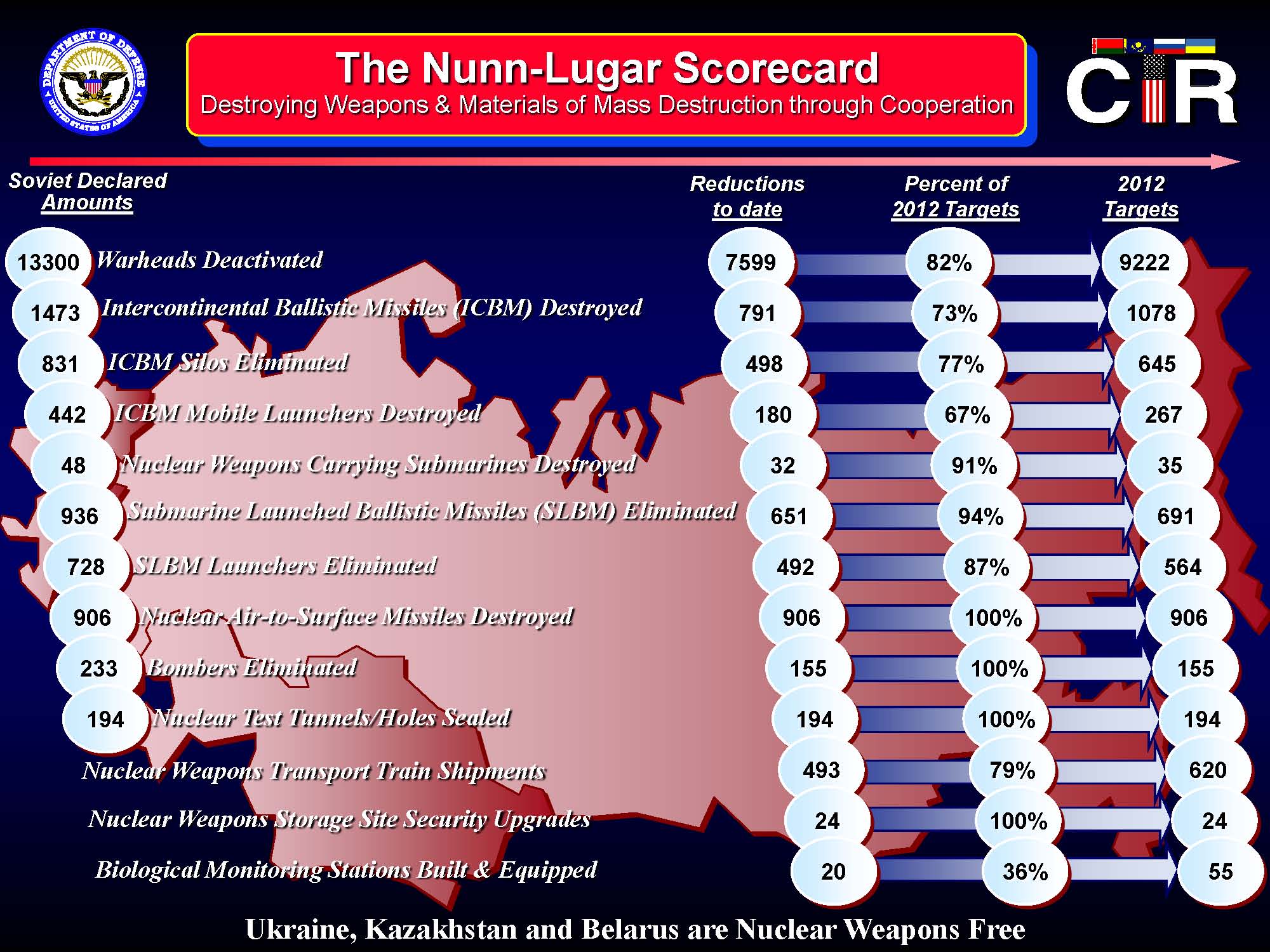The Nunn-Lugar Cooperative Threat Reduction Program
Nunn-Lugar and Arms Control key to Future Nuclear and Biological Weapons Reductions
On January 28, 2010, Senator Dick Lugar outlined important issues in arms control targets, treaty negotiations and the ability of the Nunn-Lugar program to achieve results in a speech to the Conference on Strategic Weapons in the 21st Century.
"We hope for and anticipate constructive movement in arms control on the world's biggest stages. But we should be cautious in our estimates of the influence of U.S. arsenal cuts on the behavior of smaller nuclear powers and aspirants. I believe that our success in encouraging others to abandon weapons or limit their expansion will depend much more on the hard work of expanding arms control and non-proliferation tools and addressing regional circumstances that influence the choices of governments related to weapons of mass destruction."
"The Nunn-Lugar program is well positioned to enter a new phase of global security engagement. Nunn-Lugar now has more flexibility to meet unexpected threats in locations around the world. It has the authority to spend up to 10 percent of annual Nunn-Lugar program funds notwithstanding any other law. The Secretary of Defense has the authority to accept funds from foreign governments and other entities to contribute to activities carried out under Nunn-Lugar."
Lugar touts Nunn-Lugar successes on Senate floor
Senator Dick Lugar took to the floor of the Senate on December 18, 2009, to tout the successes of the Nunn-Lugar Cooperation Threat Reduction program.
As START Treaty negotiations continue in Geneva, Switzerland, and President Barack Obama and Russian President Dmitry Medvedev discuss an agreement on the sidelines of the Copenhagen meeting, Lugar continued to draw attention to the practical, day-by-day progress of dismantling and destroying weapons and materials of mass destruction.
"The Nunn-Lugar program has demonstrated that the threat of weapons of mass destruction can lead to extraordinary outcomes based on mutual interest. No one would have predicted in the 1980s that Americans and Russians would be working together to destroy weapons in the former Soviet Union. Taking the long view, a satisfactory level of accountability, transparency, and safety must be established in every nation with a WMD program," Lugar said. "The Nunn-Lugar program is an engine of non-proliferation cooperation and expertise that can be applied around the world."
The Nunn-Lugar Scorecard
 The Nunn-Lugar scorecard now totals 7,599 strategic nuclear warheads deactivated, 791 intercontinental ballistic missiles (ICBMs) destroyed, 498 ICBM silos eliminated, 180 ICBM mobile launchers destroyed, 651 submarine launched ballistic missiles (SLBMs) eliminated, 492 SLBM launchers eliminated, 32 nuclear submarines capable of launching ballistic missiles destroyed, 155 bomber eliminated, 906 nuclear air-to-surface missiles (ASMs) destroyed, 194 nuclear test tunnels eliminated, 493 nuclear weapons transport train shipments secured, upgraded security at 24 nuclear weapons storage sites, built and equipped 20 biological monitoring stations, and neutralized 1569.5 metric tons of Russian & Albanian chemical weapons agent. Perhaps most importantly, Ukraine, Kazakhstan, and Belarus are nuclear weapons free as a result of cooperative efforts under the Nunn-Lugar program. Those countries were the third, fourth and eighth largest nuclear weapons powers in the world.
The Nunn-Lugar scorecard now totals 7,599 strategic nuclear warheads deactivated, 791 intercontinental ballistic missiles (ICBMs) destroyed, 498 ICBM silos eliminated, 180 ICBM mobile launchers destroyed, 651 submarine launched ballistic missiles (SLBMs) eliminated, 492 SLBM launchers eliminated, 32 nuclear submarines capable of launching ballistic missiles destroyed, 155 bomber eliminated, 906 nuclear air-to-surface missiles (ASMs) destroyed, 194 nuclear test tunnels eliminated, 493 nuclear weapons transport train shipments secured, upgraded security at 24 nuclear weapons storage sites, built and equipped 20 biological monitoring stations, and neutralized 1569.5 metric tons of Russian & Albanian chemical weapons agent. Perhaps most importantly, Ukraine, Kazakhstan, and Belarus are nuclear weapons free as a result of cooperative efforts under the Nunn-Lugar program. Those countries were the third, fourth and eighth largest nuclear weapons powers in the world.
Beyond nuclear, chemical and biological elimination, the Nunn-Lugar program has worked to reemploy scientists and facilities related to weapons of mass destruction in peaceful research initiatives. The International Science and Technology Centers, of which the United States is the leading sponsor, engaged 58,000 former weapons scientists in peaceful work. The National Nuclear Security Administration's Global Initiatives for Proliferation Prevention program has funded over 750 projects, engaging thousands of former weapons scientists at over 180 facilities and resulting in the creation of 2,300 new peaceful high-tech jobs.


